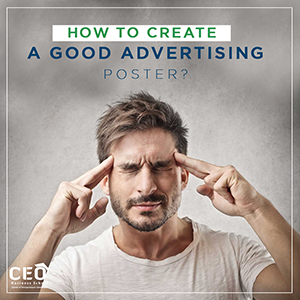
How to create a good advertising poster?
he birth and evolution of advertising posters in the second half of the nineteenth century were in phase with the different aesthetic styles that successively dominated the visual arts of each period: Constructivism, Art Nouveau, Futurism, the Art Deco, Surrealism or Pop-Art. For this, the poster has become an echo popularizing each of the predominant plastic styles in each era.
Definition and objectives of an advertising poster
Poster means any printed design that exceeds the size of DIN A3 and visually exposes an advertisement of any kind. The goal is to capture the attention of the moving public. In this sense, a poster should have a large size as well as a high-impact design, in order to be spotted at great distances. To do this, the elements to take into consideration to create a good poster are:
Images
Graphics
Fonts
The text
The luminosity
All these parameters should be positioned in order to reach the right balance to generate dynamism and sensation of movement. The design or creation of advertising posters is one of the most attractive challenges that the designer may encounter in his work, because there is a fundamental difference with other means of graphic communication: a poster or a poster are intended to attract public attention when it is moving.
Essential features of an effective poster
A poster must have a good balance of all the elements it contains. Remarkable for its size, its graphic design, its colors and the proportion between the sides of the sheet. Graphics, photos, and text must represent a line of communication that allows the human eye (and the brain) to move from one information point to another. It creates movement and dynamism. Informative data points are not accidentally placed, but are created by the designer to influence the reader.
How to design a poster?
The color of the poster text should contrast with the background color: if the background is dark, use light letters and vice versa. In a poster, text and fonts are important elements that must be highlighted using different colors and font sizes. A poster that is not “loaded” in content is more legible. If there is a lot of information that needs to be included, try to turn the data into graphics. The ideal is to design a poster that answers the following questions:
Who will she lead?
What is the basic basic idea presented on the poster?
When is it presented: promotion start date?
How is it presented?
What does the client want to read?
This is the most important question. The customer must obtain a benefit (material or immaterial) by seeing the poster. These benefits help determine what we offer our customers, help reduce advertising costs without commercial and profitable results, and help make customer communication more cost-effective.
Among the posters already famous worldwide, for example:
The BBDO agency for the Smart Brabus
Arnold Worldwide for McDonald’s Banana Bread
Gaumont for the film “37.2 ° in the morning”
Future, in 1981 for his self-promotion announcing “September 2, I remove the top”
The photographer Oliviero Toscani for Benetton in the 80s

